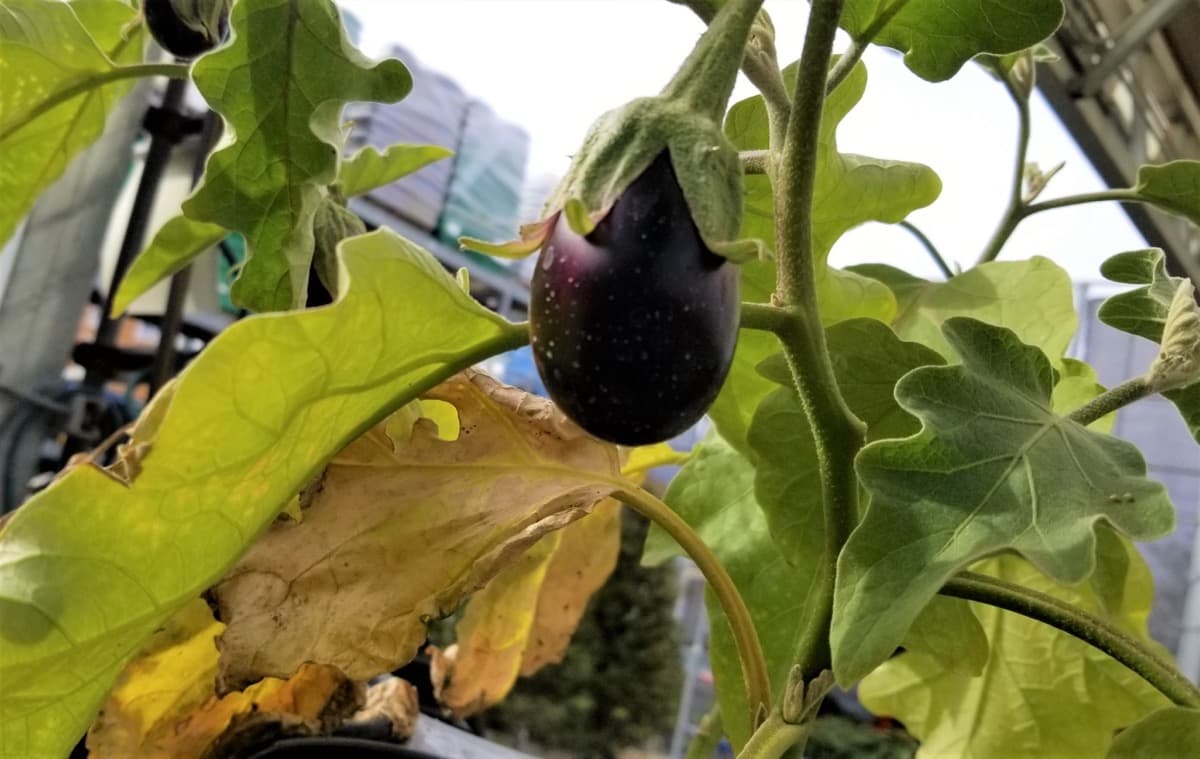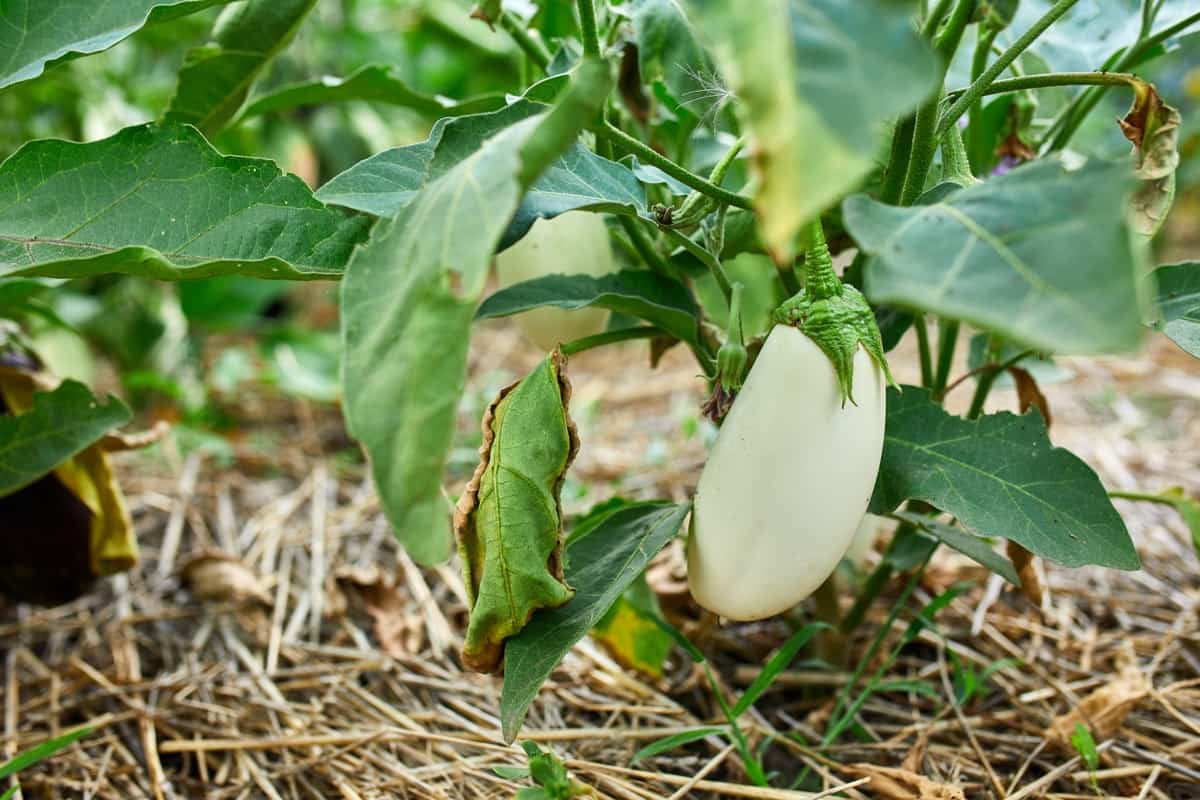Bacterial wilt is a serious plant disease caused by the soil-borne bacterium Ralstonia solanacearum (formerly Pseudomonas solanacearum). It affects many plant species, including vegetables, fruits, ornamental plants, and important crops. The disease is characterized by wilting, stunting, yellowing of foliage, and eventual collapse of the entire plant.

Once infected, plants typically die within a few weeks or months. Bacterial wilt can cause significant yield losses and can be particularly devastating in areas with warm, humid climates and heavy rainfall.
Bacterial Wilt Management in Eggplant (Brinjal)
The Disease cycle of Bacterial Wilt
- Bacteria enter xylem vessels: The bacteria enter the xylem vessels of the leaf veins and move down the petiole and vine.
- Bacteria spread to adjacent vessels: The bacteria spread to adjacent vessels through the dissolved cell wall, clogging the plant vessels and causing discoloration of the xylem vessels.
- Bacteria multiply: The bacteria continue multiplying, forming visible ooze masses.
- Beetles lay eggs: Beetles lay eggs near young plants, and larvae attack plant roots. Larvae pupate in the soil and emerge as adults, usually in August.
- Bacteria contaminate beetles: Emerging adults become contaminated with bacteria upon feeding on infected plants.
- Beetles spread bacteria: Beetles feed on and contaminate cucurbit plants with bacteria. Bacteria are deposited with the insect feces on leaf wounds.
- Bacteria overwinter: Bacteria overwinter in the striped and spotted cucumber beetles. Beetles usually appear when plants emerge in spring.
The causal organism of Bacterial Wilt Disease
- Bacterial wilt is primarily caused by the Ralstonia solanacearum bacterium, which can survive in the soil for several years.
- The bacterium mainly inhabits the roots of susceptible plants and enters the root system through wounds caused by farm tools, equipment, or soil pests.
Causes/Conditions favorable for Bacterial Wilt Disease spread in the field.
- High temperatures: Bacterial wilt symptoms are favored by high temperatures ranging between 30-35°C. High temperatures can increase the rate of bacterial multiplication and symptom expression, leading to a rapid spread of the disease in the field.
- High soil moisture: High soil moisture levels can create favorable conditions for the survival and multiplication of the bacterial wilt pathogen. The pathogen can easily spread through waterlogged soils, infecting healthy plants and increasing disease incidence.
Symptoms of Bacterial wilt in Eggplant
- Wilting: The affected plants exhibit wilting symptoms, starting from the lower leaves, which hang and then wilt. The wilting progresses upwards, eventually resulting in the collapse of the entire plant.
- Stunting: Bacterial wilt can cause stunted growth in eggplants, leading to reduced yields.
- Yellowing of foliage: The leaves of affected plants turn yellow, and the foliage may appear wilted and scorched.
- Vascular browning: The vascular system of the affected plant turns brown due to bacterial infection. This symptom is one of the most reliable ways to diagnose bacterial wilt.
- Bacterial ooze: A bacterial ooze may be visible on the affected parts of the plant, such as stems and leaves.
- Noontime wilt: Infected plants may show wilting symptoms during the day, especially at noontime, but recover at night. However, these plants will eventually die.
In case you missed it: Carp Erythrodermatitis Disease Management: Symptoms, Management, Prevention, Causes, Control, and Treatment

Bacterial Wilt Management in Eggplant by Cultural Method
- Summer ploughing: This involves deep ploughing of the soil during the summer to expose the soil to the sun and help reduce the bacterial population.
- Crop rotation: Crop rotation involves alternating Eggplant with other crops, such as cereals or cruciferous vegetables, to reduce the soil’s buildup of bacterial wilt pathogens.
- Solarization of nursery beds: This involves covering nursery beds with a clear plastic sheet to trap heat and kill bacterial wilt pathogens in the soil.
- Fallow land: Keeping the land fallow for a season can help destroy harmful pathogens that may be present in the soil.
- Good drainage: Avoid waterlogging and provide drainage facilities to reduce the risk of bacterial wilt infection in eggplants.
Bacterial Wilt Management in Eggplant by Biological Method
- Seed treatment with Streptocycline (150 ppm) for 90 min: Streptocycline is an antibiotic that can treat seeds before planting to prevent bacterial wilt. It is typically used at 150 parts per million (ppm) concentration and applied to the seeds for 90 minutes.
- Soil application of biocontrol agents like Bacillus subtilis or Trichoderma harzianum has shown promising results in reducing the incidence of bacterial wilt.
Bacterial Wilt Management in Eggplant by Chemical Method
- Spray copper fungicide to control disease (2% Bordeaux mixture): Copper fungicides, such as Bordeaux mixture, can control bacterial wilt on plants. Bordeaux mixture is a mixture of copper sulfate and hydrated lime and is typically applied as a spray at a concentration of 2%.
- Drench in and around the diseased area with copper hydroxide 77%WP @ three g/liter: Copper hydroxide is another copper-based fungicide that can control bacterial wilt. It is typically applied as a drench around the affected area at a concentration of 3 grams per liter.
- Soil fumigation with Formalin at 7% before sowing: Formalin, also known as formaldehyde, is a chemical used to fumigate the soil before planting to kill pathogens like Ralstonia solanacearum. It is typically used at a concentration of 7% and applied to the soil a few days before sowing.
Bacterial Wilt Management in Eggplant by Organic Method
- Neem cake: Neem cake is a by-product of neem seed oil production and contains antifungal and antibacterial compounds. Applying neem cake to the soil at a rate of 100 kg/acre can help reduce the population of bacterial pathogens that cause wilt.
- Pseudomonas fluorescens: Pseudomonas fluorescens is a beneficial bacterium that can be applied to the soil to suppress bacterial wilt. It colonizes the root system and produces toxic compounds for bacterial pathogens. Talc-based formulations of Pseudomonas fluorescens pre-colonized in farmyard manure can be applied at 2.5 kg/ha.
Preventive Measures for Control of Bacterial Wilt
- Avoid injuring the plant: Avoid the plant while weeding or performing field operations, as wounds can provide entry points for the bacterial wilt pathogen.
- Frequent weeding: Weed frequently to remove alternate hosts of the disease and reduce the incidence of bacterial wilt.
- Well-drained soils: Plant in well-drained soils and avoid overwatering plants, as saturated soils can increase the risk of bacterial wilt.
- Weed-free nursery: Keep the nursery weed-free to reduce the incidence of bacterial wilt in the seedlings.
- Soil pH: Use limestone to increase soil pH to 6-7, as bacterial wilt prefers acidic soils.
In case you missed it: How to Manage Downey Mildew in Home Garden: Symptoms, Causes, Cultural, Biological, Chemical, Natural, and Organic Control

Conclusion
Effective control measures for bacterial wilt include cultural, biological, and chemical methods, but prevention is the best approach. It is essential to maintain good agricultural practices, such as crop rotation, weed management, and proper sanitation of tools and equipment, to prevent the spread of the disease. Early detection and prompt control measures can minimize crop losses and preserve yields. By implementing effective management strategies, farmers can reduce the impact of bacterial wilt and maintain healthy and productive crops.
- Beneficial Insects in Pest Management
- Natural Solutions for Pest Control in Flower Gardens
- Types of Fungicides Used in Agriculture
- Common Issues in the Fruit Development Stage of Pomegranate Farming
- Fruit Development Issues in Papaya: Easy Solutions and Treatment
- Soil-Borne Diseases and How to Protect Your Plants
- Practices to Prevent Disease Spread in the Garden
- From Wilted to Thriving: How to Treat Root Rot Naturally in Houseplants
- Natural Remedies to Cure Brown Spots on Fig Tree Leaves